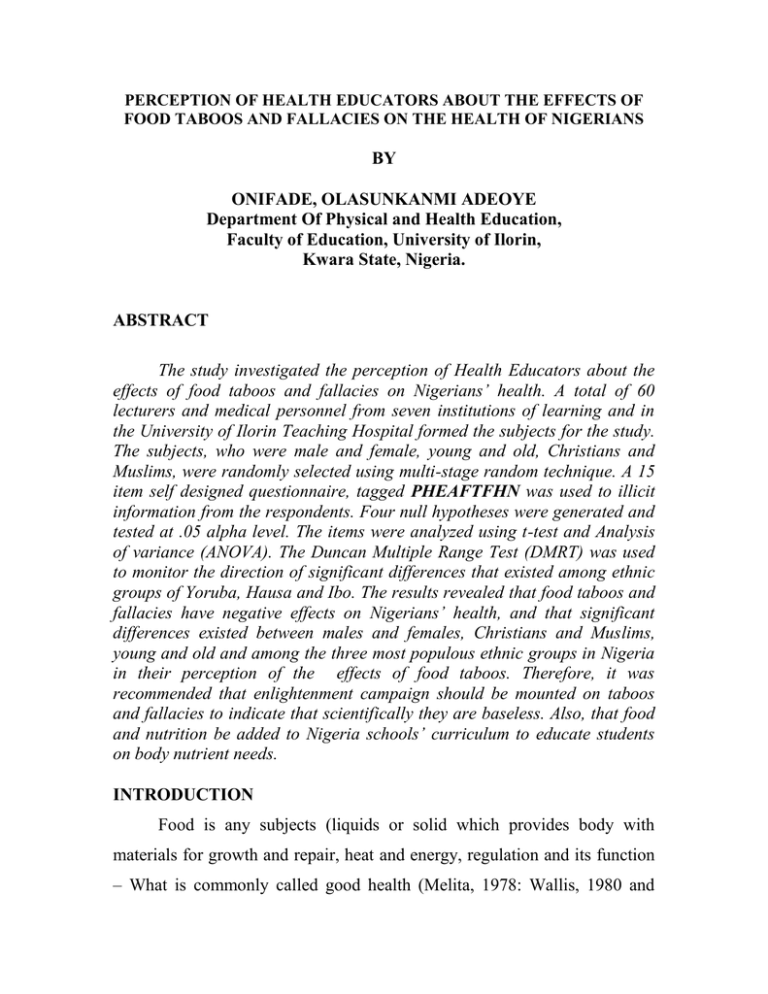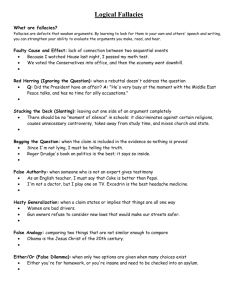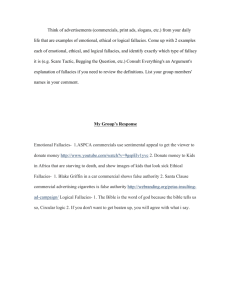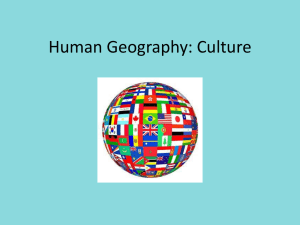PERCEPTION OF HEALTH EDUCATORS ABOUT THE EFFECTS OF
advertisement

PERCEPTION OF HEALTH EDUCATORS ABOUT THE EFFECTS OF FOOD TABOOS AND FALLACIES ON THE HEALTH OF NIGERIANS BY ONIFADE, OLASUNKANMI ADEOYE Department Of Physical and Health Education, Faculty of Education, University of Ilorin, Kwara State, Nigeria. ABSTRACT The study investigated the perception of Health Educators about the effects of food taboos and fallacies on Nigerians’ health. A total of 60 lecturers and medical personnel from seven institutions of learning and in the University of Ilorin Teaching Hospital formed the subjects for the study. The subjects, who were male and female, young and old, Christians and Muslims, were randomly selected using multi-stage random technique. A 15 item self designed questionnaire, tagged PHEAFTFHN was used to illicit information from the respondents. Four null hypotheses were generated and tested at .05 alpha level. The items were analyzed using t-test and Analysis of variance (ANOVA). The Duncan Multiple Range Test (DMRT) was used to monitor the direction of significant differences that existed among ethnic groups of Yoruba, Hausa and Ibo. The results revealed that food taboos and fallacies have negative effects on Nigerians’ health, and that significant differences existed between males and females, Christians and Muslims, young and old and among the three most populous ethnic groups in Nigeria in their perception of the effects of food taboos. Therefore, it was recommended that enlightenment campaign should be mounted on taboos and fallacies to indicate that scientifically they are baseless. Also, that food and nutrition be added to Nigeria schools’ curriculum to educate students on body nutrient needs. INTRODUCTION Food is any subjects (liquids or solid which provides body with materials for growth and repair, heat and energy, regulation and its function – What is commonly called good health (Melita, 1978: Wallis, 1980 and Adeyemi, 1996). It may also be regarded as the material which, when taken, enables humans to grow to maintain and reproduce themselves it includes the staple dishes, snacks, chewing gum, beverages. Drinks other than water and minerals, both solid and liquid ones used as ingredients in the preparation of food and drinks (John, 1995. 1996). Food is one of our most important daily needs. The kinds of food that people eat depend largely on what plants they grow and what animals they can raise. It also depends on what they can buy from other regions or countries. Customs and many religions also influence what people eat. For example, Buddhists are not allowed to eat any meat, also Muslims in Nigeria and other parts of the world also do not eat pork meat and Christians e.g. the Jehovah witnesses and members of the Celestial Church of Christ. Hindus consider the cow sacred and eat no beef. Some Hindus eat no animal food except milk and dairy products because their beliefs forbid them to kill animals. Also, Roman Catholics do not eat meat on certain days during lent (Adeoye, 1981); Haghind, David, Tillgren & Peterson, 1996). According to Adeoye (1981) and Hodder and strughton, (1996), some persons pick and choose the food they eat on the basis of food, taboos fads and fallacies. Eating habits have long been partly controlled by beliefs about what is good for people to eat. For example, some people have some thought that tomatoes were poisonous and refused to eat them. Today, some people avoid white bread and canned food because milling and canning processes make them impure. The Sango (god of iron) worshippers in Yoruba land in Nigeria do not eat cowpea because they believe that the wrath of god of iron would descend on them. People from Ozuzu town in Etche Local Government Area of River State of Nigeria do not eat Etu (special cow meat) because Amadioha (deity god) hates, it because mashing its faeces results in skin peeling and massive death of the citizens. In Isiala Ngura Local Government Area of Abia State of Nigeria, snail and dry fish (Magala) are forbidden because snail invokes saliva on child right from womb and dry fish (Magala) causes rashes resembling burn of fire if the stick from it is roasted and put on fire after consumption. The people of Ideato North Local Government Area of Imo State trusted that eating snake is forbidden because it protects them from enemies during past wars. Also, Banga soup and periwinkle were forbidden in Umuahia because the soup prolong labour in child delivery in pregnant women and manifest small pox on the consumer’s body. Perinwinkle makes pregnant women to become very lazy and bring drawing of saliva to babies (Peter, 2000). However, most of the food forbidden counted as taboos and fads above by certain groups of people (i.e cowpeas, white bread, periwinkle vegetable meat, nuts and so on) belong to classes of protein carbohydrate, fats, mineral and vitamins for which the body require some kilocalories for normal growth and development. For example proteins that are present in some of the forbidden foods enhance growth and repair worn out tissues in the body (Sandra, 1996; Bello, 2002). Carbohydrate – Foods rich in carbohydrates are numerous: they include potatoes, bread, cereals, cakes, pastries, yam, cassava, milk, chocolate, fruit juices and fruits. These foods supply fuel for energy, which the body needs (Wallis, 1980; Sandra, 1996). Fats – Meat, fish milk, nuts olive oil, cheese and margarine that are fads and fallacies are our chief sources of fuel for energy, cushion body organs and keep the body warm (Adeoye 1981). The recommended daily intake for fats and carbohydrate is boys: 3,3-12. 6MJ; girls; 33-9.6MJ. Men: 11.3-15.1 MJ; (Melita, 1978; Umeh 1985). Mineral Elements – Some mineral elements that are foods but required by the body include calcium, iron, sodium, potassium to mention a few of them. Some of the functions of minerals elements are formation of bone and teeth, assist in blood cloth, gives blood its red colour, and essential for proper functioning of thyroid gland etc (Luccile, et al; 1989). Vitamins as their name suggests are vital to health. Only very small quantities are required but they are absolutely essential. Vitamins could either be water soluble (B and C) or fat soluble (A, D, E and K) (Nwankwo, 1992). Most foods that are eaten in our day-to-day life in Nigeria fall into the group of fallacies, taboos and superstitions thereby causing food deficiency diseases. Such diseases include night blindness, bitot’s spot, corneal xerosis, keratomalacia and xerophthalmia (toad skin) or lehthyosis (fish skin) that are deficiency in vitamin A (Abdulraheem, 2003). Rickets and esteromalacia – deficiency in vitamin D as a result of inadequate dietary intake or inadequate exposure to sunlight (Goodhert, 1980); deficiency in protein results in weight loss, anaemia and retarded growth (Adejumobi, Adeniyi and Oyinbo, 1994); in minerals, deficiency of iron causes anaemia in which the red blood cells are smaller in size than normal (microcytic anaemia) (Faechem & Jamison, 1991); deficiency in vitamin K may result in prolonging the clotting time or results in not clotting, while deficiency in vitamin C causes a variety of diseases which include beri-beri, pellagra and anaemia (House, 1992 and Peter 2000). THE PROBLEM Despite the efforts of the Nigerian government to see that all Nigerian are educated through bringing programmes such as Nomadic Education Programme (NEP), Adult Education Programme (A.E.P) (that is expected to enlighten and make its citizenry docile and passive to food taboos and fallacies that could affect their health Nigerians still hold these cultural beliefs which affect their health through denial of eating some foods that are delicious and required for body growth and development. Consequently, some had deficiency diseases, which in some cases result to death, although some Nigerians still trusted that certain deficiency diseases are not as a result of taboos, fads and fallacies. Therefore, the major problem of this study is to find out the perception of Health Educators about the effects of food taboos and fallacies on the health of Nigerians. PURPOSE OF THE STUDY The study therefore was primarily intended to seek whether food taboos, fads and fallacies are perceived by health educators to have effects on the health of the Nigerians. METHODS Population and sample The target population for the study was Health Educators in Health Institutions in Kwara State. Random sample technique was used in selecting the subjects on a multistage basis for this study. The sample consisted of 10 lecturers of the School of Health Technology, Offa; 20 lecturers from the school of Nursing, Ilorin; 5 lecturers from the Kwara State College of Education, Oro, and 5 lecturers from the College of Education, Ilorin, 5 lecturers from Epidemilogical unit, University of Ilorin Teaching Hospital, and 5 lecturers from the Department of Physical and Health Education, University of Ilorin. A total of 60 lecturers (Health Education) who included Christian and Muslims young and old, male and female, Yoruba, Hausa and Ibo respondent took part in the study. INSTRUMENT The researcher designed the Questionnaire on the Health Educators Perceived Effects of food Taboos and Fallacies on Health of Nigerians (PHEAEFTFHN) and validated by jury of experts in the related field. The instrument consisted of two sections: section A consisted of items on biodata such as age, gender, ethnic group, and religion. Section B consisted of 15 items, 14 of which were used to elicit responses on the perceived effects of food taboos and fallacies on health of Nigerians, while the 15 th item was on open-ended, designed to know whether there are other effects of food taboos and fallacies on health apart from food efficiency diseases. Four Point Likert rating scale was used for the first 14 items to indicate the level of the effect of food taboos and fallacies on health of Nigerians. A reliability co-efficient of 0.81 was obtained for the instrument (PHEAEFTFHN) with the use of test-retest procedure. RESULT AND DISCUSSION TABLE I t-test differences between Christian and Muslims in their perceptions about the effects of food taboos and fallacies on health. Religion N Means S.D. D.F. t-cal t-crit P Christian 39 36.82 5.06 58 Muslim 21 30.91 2.03 1.96 .05 4.86 Remarks: P >. 05. Not significant. Ho Rejected Table 1 above showed that when Christian and Muslim were compared on the basis of their perception on the effect of food taboos and fallacies on health, significant mean difference was observed. The calculated t-value was 2.03. This was greater than the critical t-test of 1.96 and was significant at .05 alpha levels. On this basis, the null significant difference between Christian and Muslim in their perception of the effect of food taboos and fallacies on health was rejected. TABLE II: t-test for differences between male and female respondents in their perceptions about the effects of food taboos and fallacies on health. Gender N Means S.D. D.F. t-cal t-crit P Male 15 31.15 5.25 58 Female 45 31.59 2.58 1.96 .05 4.70 Remark: P< 05, significant, Ho Rejected Table II above showed that when male and female respondents’ perceptions of the effects of food taboos and fallacies on health were compared, significant mean difference was observed. The calculated t-value; was 2.58, critical t-value 1.96 and 58 degree of freedom at .05 alpha level. This showed that the calculated value of 2.58 was higher than the t-critical value of 1.96. Therefore, the null hypothesis that stated that there is no significant difference in their perception between male and female respondents in their perception of the effect of food taboos and fallacies on health was rejected. TABLE III t-test for differences between young and old respondents in their perceptions about the effects of food taboos and fallacies on health. Age N Means S.D. D.F. t-cal t-crit P Young 39 24.16 4.14 58 Old 21 21.78 2.19 1.96 .05 3.86 Remarks: P< .05, significant, Ho Rejected Table III above showed that when young and old respondents were compared on the basis of their perceptions of effect of food taboos and fallacies on health, significant difference was observed. The calculated tvalue was 2.19, critical t-value of 1.96 and 58 as the degree of freedom at .05 alpha level. This showed that, the calculated t-value of 1.96. Therefore, the null hypothesis, which stated that there is no significant difference in the perception of the effect of food taboos and fallacies on health between young and old respondents, was rejected. Hypothesis iv There is no significant difference in the perception of the effects of food taboos and fallacies on health among the three ethnic groups of Hausa, and Ibo and Yoruba. TABLE IV ANOVA for differences among in the ethnic groups in their perception on about the effect of food taboos and fallacies on health Source Between group D.F 3 Within group 57 Total 60 Sum of square 422.9872 1000251.9062 Mean F- F- square Ratio Probab 49182 0.021 140.9957 286680 Remark; P. 05, Significant at .05 alpha levels, Ho Rejected Table IV above compared the perception of the three major ethnic groups (Hausa, Ibo and Yoruba) conception of the effect of food taboos and fallacies on health. The analysis was done by way of analysis of variance. The table compared that F-ration (4, 9182) is greater than the P. Probability of (0.0021). On this note, the hypothesis that stated that there is no significant difference in the perception of the effects of food taboos and fallacies on health among the three (Hausa, Ibo and Yoruba) ethnic groups in Nigeria was rejected. Since there were three major ethnic groups in Nigeria, Duncan’s Multiple Range Test (DMRT) was computed to know the direction of the difference. Table V below, represents the direction of the difference. Table V Duncan’s Multiple Range Test (DMRT) comparing the Difference Among Respondents from Hausa, Ibo and Yoruba. Ethnic groups Count Means S.D. Duncan Grouping Hausa 06 28.2609 5.5232 A Ibo 19 28.8389 5.1842 B Yoruba 35 28.6999 5.2101 B Note: Means with the same letters are not significantly different but mean with different letter is a bit different from the other. CONCLUSION The result of the Duncan grouping shows just slight (less significant) difference, although Ibo and Yoruba have similar perceptions however, their perception is just slightly different from that of the Hausas. DISCUSSION The finding revealed that Christians and Muslims Health Educators did not share the same taboos and fallacies on food. For example, the Muslims forbid the eating of pork, crab and duck while Christians consumed these meats freely pork, crab and duck have content of protein with biological value of (Pork = 74%, Crab 31% and duck 16%) which are essential for brain development in humans. This finding is in line with Christian respondents but contrary to Muslim respondents. Lucille (1989); John (1995) and Hodder (1995) who found that meat contain protein that is good for body growth, development, and repair of body the tissue and supply of the body needed heat. However, the Health Educators’ belief that such meat should not be eaten freely, may lead to some protein deficiency diseases such as Kwashiorkor, diarrhea and mental apathy. Male and female Health Educators perceived the effects of food taboos and fallacies on health differently. The male respondents concluded that food deficiency diseases such as Kwashiorkor, diabetes, hyperkeratosis, osteomalacia are caused by fear that emanated from eating some foods (food taboos and fallacies) that are rich is supplying the body necessary nutrients. The female respondents did not feel it the same way. The thought of the male respondents is in line with Nwankwo (1992); Ojofeitimi (1995) and Peter (2000) who observed that, most of the food deficiency diseases in Nigeria are caused by the way Nigerians select what they eat through their cultural beliefs. However, female respondents are contrary to the above; they thought that diseases have nothing to do with food deficiency but that it is as a result of lack of adequate rest and evil machinations of enemies. Furthermore, the finding of the study revealed that younger Health Educator’s perception of the effects of food taboos and fallacies on the health of Nigerians is different from their old counterparts. For example, the younger respondents trusted that most of the forbid foods in different cultural background for example cowpeas that was believed could cause wrath of god of iron by Sango worshipperS in Yoruba land, also, snail and dried fish (Magala) believed to evoke saliva and rashes on children if eaten by them were perceived to be harmless by younger respondents but were thought to be harmful by older respondents. The believe of the younger respondents corroborate that of Eleanor (1981); Oyinloye (1990) and Ojofeitimi (1995) who observed that the protein contents in cowpeas, snail and dried fish are good and necessary for body growth, development and repair of worn out cells. The finding of this study indicated that significant differences existed among the three ethnic groups in their perceptions of the effects of food taboos and fallacies on health. Although, the perception of the Ibos and Yoruba are slightly similar, they are different from that of the Hausas. In Yoruba land it is believed that meat of different kinds should not be given to children; they will turn to stealing. The believe in Ibo land also, is that Periwinkle and Banga soup (which are rich in protein), were forbidden because it was superstitiously believed that the periwinkle and Banga soup prolong labour in child delivery in pregnant women and manifest small pox on the consumers. The refuser (as a result of food taboos and fallacies) in eating the above mention protein producing soup and meats and other proteinous food could be the reason why protein deficiency diseases are common among the children and pregnant women in Yoruba land and Ibo land. The result of this finding supports Stone and Cozen (1976); Emina and Ndu (1991) and William (1991) who found that assorted meats (including periwinkle and Banga soup) are highly nutritious and good sources of protein supply to the body. In conclusion, Health Educators in Nigeria perceived that food taboos and fallacies tremendously affect the Health status of Nigerians; as in most cases such beliefs lead to diseases and death in some cases. The respondents also belief that a few of the food taboos and fallacies (that emanated from cultural backgrounds are still presently with us. However, religious inclinations of individual are making them to be a thing of the past. RECOMMENDATIONS Based on the findings of this study, the following recommendations were made; 1. There is an urgent need to educate Nigerians on the awareness of taboos, food fallacies, food related superstition so that they know that taboo, superstitions are just vogue and scientifically baseless. 2. The Federal Ministry of Education should incorporate the topic Food and Nutrition in to schools curriculum from primary to tertiary institutions so that students know the types of nutrients in different food and those needed by the body and eat them. 3. There should be free treatment services of food deficiency diseases and at the point of treatment enlightenment campaign mounted to educate victims on food taboos fallacies. REFERENCES Abdulraheem, O.O. (2003) Cultural beliefs influence on low animal production in Ilorin Unpublished Seminar Paper, Ilorin: Ministry of Agriculture and Natural Resources. Adeyemi, L.A. (1996) Biology as a general course. 2nd Edition, Ilorin: T.P. Press & C.S. Eleanor: Noss Whitney (1981) Understanding Nutrition. 2nd Edition Minnesota: West Publishing Co. Feacherm, R.G & Jamison D.T (1991) Disease and mortality in Sub-Sahara Africa, World Bank Report; Oxford University Press. Goodhert, R.S. (1980), Modern Nutrition in Health and Disease. London: Kimpton Publishers Ltd. Hodder and Stonghton (1996) Human Physiology and Health. 10th edition, Impression London: Hodder Headline Plc. Howe, P.S. (1992) Basic Nutrition in Health and Disease, Toronto: W.B. Publishers. Huglund, J.A; David F; Tilgren, P. & Patterson, B (1996). Creating Supportive Environment for Health: Stories from the Third International Conference on Health promotion. The Publication of the World Health Organization. John, D.K (1995) Nutrition Almanac-Nutrition search. 1st Edition. New York: Mc Graw: Hill Paper Back. Luccile, K; Babara, A Connie Krebs – Shannon (1989) Medical Assisting. 2nd Edition. New York. Delmar Publishers Inc Malita, M.N. (1978) Cookery for schools. New Metric Edition. Ibadan: Oluseyi Press Limited Nwankwo, E.I (1992) Applied Anatomy and Physiology. Ibadan: Sibon Books Limited. Oyinloye, T. (1990) Superstitions Belief held by Senior Secondary School Students in Selected Biology Concepts. Unpublished M.Ed Thesis, University of Ilorin. Peter, I.O.B (2000). The nutrition needs of the adolescents. 2nd Edition Benin K Light Publishers. Sandra, A. (1996) Biology: Understanding Life. St. Louis: A Times Mirror Company. Smith, IO.F; Ojofeitimi, E.O. (1995) Nutrition and diet therapy for health care professions in Africa. Ibadan Y – Books. Stone, R.H; Cozens, A.B; Emina, F.1; Ndu, F.O.C (1976) New Biology for West African Schools. London: Longman Group Limited. Wallis M.A. (1980). Human Biology. A Textbook of human anatomy, physiology and hygiene. 2nd edition. Great Britain: R.I. Acford Ltd. William, D; Mc Ardle: Frank, I. Katch; Victor, L. Katch (1991). Exercise Physiology, Energy, Nutrition and human performance. 3rd Edition U.S.A Lea and Febiger.


